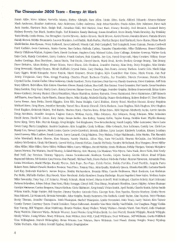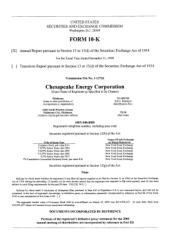Chesapeake Energy 1999 Annual Report Download - page 19
Download and view the complete annual report
Please find page 19 of the 1999 Chesapeake Energy annual report below. You can navigate through the pages in the report by either clicking on the pages listed below, or by using the keyword search tool below to find specific information within the annual report.
number of wells or the locations at which the Company can drill. The extent of any impact on the Company of such
restrictions cannot be predicted.
Environmental and Occupational Regulation
General. The Company's activities are subject to existing federal, state and local laws and regulations governing
environmental quality and pollution control. It is anticipated that, absent the occurrence of an extraordinary event,
compliance with existing federal, state and local laws, rules and regulations concerning the protection of the
environment and human health will not have a material effect upon the operations, capital expenditures, earnings or
the competitive position of the Company. The Company cannot predict what effect additional regulation or
legislation, enforcement policies thereunder and claims for damages for injuries to property, employees, other
persons and the environment resulting from the Company's operations could have on its activities.
Activities of the Company with respect to the exploration, development and production of oil and natural gas are
subject to stringent environmental regulation by state and federal authorities including the United States
Environmental Protection Agency ("EPA"). Such regulation has increased the cost of planning, designing, drilling,
operating and in some instances, abandoning wells. In most instances, the regulatory requirements relate to the
handling and disposal of drilling and production waste products and waste created by water and air pollution control
procedures. Although the Company believes that compliance with environmental regulations will not have a material
adverse effect on operations or earnings, risks of substantial costs and liabilities are inherent in oil and gas
operations, and there can be no assurance that significant costs and liabilities, including criminal penalties, will not
be incurred. Moreover, it is possible that other developments, such as stricter environmental laws and regulations,
and claims for damages for injuries to property or persons resulting from the Company's operations could result in
substantial costs and liabilities.
Waste Disposal. The Company currently owns or leases, and has in the past owned or leased, numerous
properties that for many years have been used for the exploration and production of oil and gas. Although the
Company has utilized operating and disposal practices that were standard in the industry at the time, hydrocarbons or
other wastes may have been disposed of or released on or under the properties owned or leased by the Company or
on or under other locations where such wastes have been taken for disposal. In addition, many of these properties
have been operated by third parties whose treatment and disposal or release of hydrocarbons or other wastes was not
under the Company's control. State and federal laws applicable to oil and natural gas wastes and properties have
gradually become more strict. Under such laws, the Company could be required to remove or remediate previously
disposed wastes (including wastes disposed of or released by prior owners or operators) or property contamination
(including groundwater contamination) or to perform remedial plugging operations to prevent future contamination.
The Company generates wastes, including hazardous wastes, that are subject to the federal Resource
Conservation and Recovery Act ("RCRA") and comparable state statutes. The EPA and various state agencies have
limited the disposal options for certain hazardous and nonhazardous wastes and are considering the adoption of
stricter disposal standards for nonhazardous wastes. Furthermore, certain wastes generated by the Company's oil and
natural gas operations that are currently exempt from treatment as hazardous wastes may in the future be designated
as hazardous wastes, and therefore be subject to considerably more rigorous and costly operating and disposal
requirements.
Superfund. The Comprehensive Environmental Response, Compensation and Liability Act ("CERCLA"), also
known as the "Superfund" law, imposes liability, without regard to fault or the legality of the original conduct, on
certain classes of persons with respect to the release of a "hazardous substance" into the environment. These persons
include the owner and operator of a site and persons that disposed of or arranged for the disposal of the hazardous
substances found at a site. CERCLA also authorizes the EPA and, in some cases, third parties to take actions in
response to threats to the public health or the environment and to seek to recover from responsible classes of persons
the costs of such action. In the course of its operations, the Company may have generated and may generate wastes
that fall within CERCLA's defmition of "hazardous substances". The Company may also be or have been an owner
of sites on which "hazardous substances" have been released. The Company may be responsible under CERCLA for
all or part of the costs to clean up sites at which such wastes have been released. To date, however, neither the
-9-
























